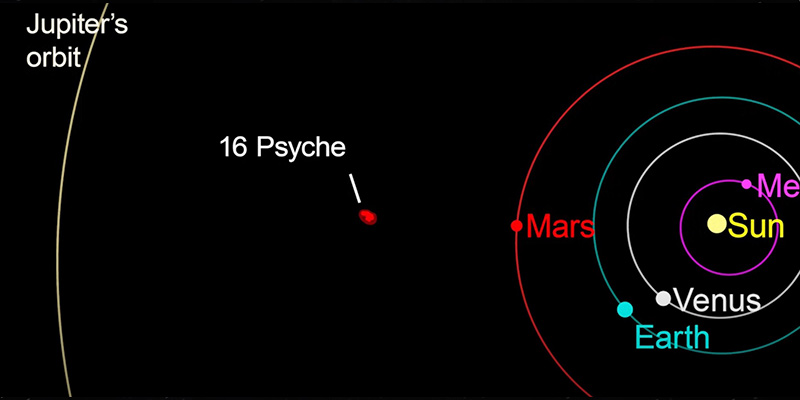- World
- Oct 09
NASA to launch Psyche mission on October 12
• NASA is targeting an October 12 lift-off for the Psyche mission, on a SpaceX Falcon Heavy rocket from Launch Complex 39A at the agency’s Kennedy Space Center in Florida.
• The Psyche spacecraft will travel about 2.2 billion miles to study a metal-rich asteroid of the same name.
• If all goes as planned, asteroid Psyche’s gravity will capture the spacecraft in late July 2029, and Psyche will begin its prime mission in August. It will spend about two years orbiting the asteroid to take pictures, map the surface, and collect data to determine Psyche’s composition.
Asteroid Psyche
• Psyche was discovered in 1852 by Italian astronomer Annibale de Gasparis. Because it was the 16th asteroid to be discovered, it is sometimes referred to as 16 Psyche. It’s named for the goddess of the soul in ancient Greek mythology, often depicted as a butterfly-winged female figure.
• Psyche orbits the Sun in the outer part of the main asteroid belt between Mars and Jupiter.
• It is approximately three times farther from the Sun than Earth.
• Scientists think asteroid Psyche could be part or all of the iron-rich core of a planetesimal, a building block of a rocky planet that never formed.
• Because Psyche and Earth orbit at different speeds, the distance from Earth to Psyche varies from less than 186 million miles to more than 372 million miles.
• Psyche is irregular and potato-like. If the asteroid were sliced in half horizontally at the equator it would measure 280 kilometers across at its widest point and 232 kilometers long. Its surface area is 165,800 square kilometers.
• The surface gravity on Psyche is much less than it is on Earth – even less than it is on Earth’s Moon. On Psyche, lifting a car would feel like lifting a large dog.
• The asteroid is most likely a survivor of multiple violent hit-and-run collisions, common when the solar system was forming.
• The asteroid also could also be something else. It could be the leftover piece of a completely different kind of iron-rich body that formed from metal-rich material somewhere in the solar system.
• Psyche may be able to show us how Earth’s core and the cores of the other terrestrial planets came to be.
• While rocks on Mars, Venus, and Earth are flush with iron oxides, Psyche’s surface doesn’t seem to feature much of these chemical compounds. This suggests that Psyche’s history differs from standard stories of planetary formation.
• If the asteroid proves to be leftover core material from a planetary building block, scientists will learn how its history resembles and diverges from that of the rocky planets. And if scientists discover that Psyche is not an exposed core, it may prove to be a never-before-seen kind of primordial solar system object.
Psyche Spacecraft
• This is NASA’s first mission to study an asteroid that has more metal than rock or ice.
• The body of the Psyche spacecraft is about the size of a small van, and it’s powered by solar electric propulsion. It has a magnetometer, a gamma-ray and neutron spectrometer, and a multispectral imager to study asteroid Psyche. The spacecraft will start sending images to Earth as soon as it spots the asteroid.
• Psyche’s multispectral imager consists of a pair of identical cameras equipped with filters and telescopic lenses to photograph the surface of the asteroid in different wavelengths of light. The cameras can take pictures in the part of the spectrum visible to the human eye, as well as in near-infrared wavelengths of light beyond what humans can see.
• The orbiter’s gamma-ray and neutron spectrometer will help scientists determine the chemical elements that make up the asteroid’s surface material.
• The orbiter’s magnetometer will look for evidence of an ancient magnetic field at asteroid Psyche.
• With its solar panels deployed at 25 meters by 7.3 meters, Psyche would just about cover a tennis court. The spacecraft body is 4.9 meters tall, including the 2-meter booms for two instruments, 2.2 meters wide, and 2.4 meters deep.
• Psyche uses solar electric propulsion. The spacecraft has four Hall-effect thrusters that use electromagnetic fields to expel charged atoms, or ions, of inert xenon gas that in turn create thrust, trailing a blue glow of xenon.
Manorama Yearbook app is now available on Google Play Store and iOS App Store


